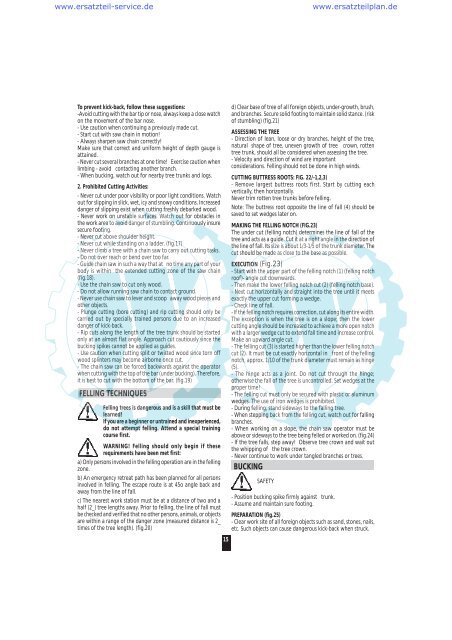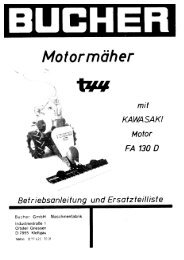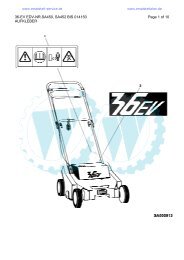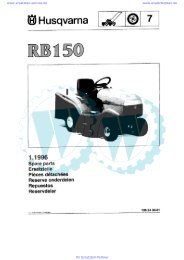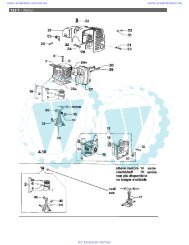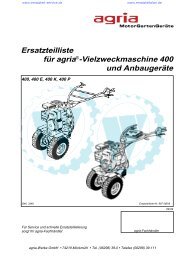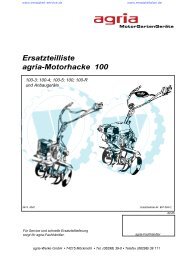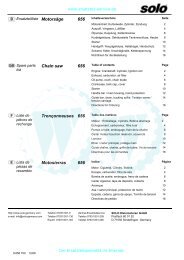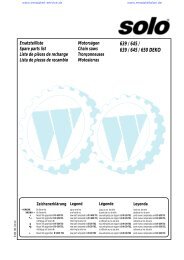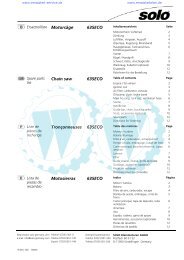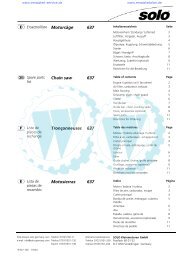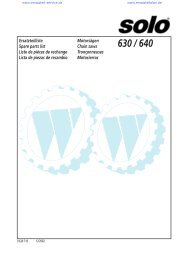Solo Gartengeraete - Ersatzteilplan
Solo Gartengeraete - Ersatzteilplan
Solo Gartengeraete - Ersatzteilplan
You also want an ePaper? Increase the reach of your titles
YUMPU automatically turns print PDFs into web optimized ePapers that Google loves.
www.ersatzteil-service.de www.ersatzteilplan.de<br />
To prevent kick-back, follow these suggestions:<br />
-Avoid cutting with the bar tip or nose, always keep a close watch<br />
on the movement of the bar nose.<br />
- Use caution when continuing a previously made cut.<br />
- Start cut with saw chain in motion!<br />
- Always sharpen saw chain correctly!<br />
Make sure that correct and uniform height of depth gauge is<br />
attained.<br />
- Never cut several branches at one time! Exercise caution when<br />
limbing - avoid contacting another branch.<br />
- When bucking, watch out for nearby tree trunks and logs.<br />
2. Prohibited Cutting Activities:<br />
- Never cut under poor visibility or poor light conditions. Watch<br />
out for slipping in slick, wet, icy and snowy conditions. Increased<br />
danger of slipping exist when cutting freshly debarked wood.<br />
- Never work on unstable surfaces. Watch out for obstacles in<br />
the work area to avoid danger of stumbling. Continuously insure<br />
secure footing.<br />
- Never cut above shoulder height.<br />
- Never cut while standing on a ladder. (fig.17)<br />
- Never climb a tree with a chain saw to carry out cutting tasks.<br />
- Do not over reach or bend over too far.<br />
- Guide chain saw in such a way that at no time any part of your<br />
body is within the extended cutting zone of the saw chain<br />
(fig.18).<br />
- Use the chain saw to cut only wood.<br />
- Do not allow running saw chain to contact ground.<br />
- Never use chain saw to lever and scoop away wood pieces and<br />
other objects.<br />
- Plunge cutting (bore cutting) and rip cutting should only be<br />
carried out by specially trained persons due to an increased<br />
danger of kick-back.<br />
- Rip cuts along the length of the tree trunk should be started<br />
only at an almost flat angle. Approach cut cautiously since the<br />
bucking spikes cannot be applied as guides.<br />
- Use caution when cutting split or twisted wood since torn off<br />
wood splinters may become airborne once cut.<br />
- The chain saw can be forced backwards against the operator<br />
when cutting with the top of the bar (under bucking). Therefore,<br />
it is best to cut with the bottom of the bar. (fig.19)<br />
FELLING TECHNIQUES<br />
Felling trees is dangerous and is a skill that must be<br />
learned!<br />
If you are a beginner or untrained and inexperienced,<br />
do not attempt felling. Attend a special training<br />
course first.<br />
WARNING! Felling should only begin if these<br />
requirements have been met first:<br />
a) Only persons involved in the felling operation are in the felling<br />
zone.<br />
b) An emergency retreat path has been planned for all persons<br />
involved in felling. The escape route is at 45o angle back and<br />
away from the line of fall.<br />
c) The nearest work station must be at a distance of two and a<br />
half (2_) tree lengths away. Prior to felling, the line of fall must<br />
be checked and verified that no other persons, animals, or objects<br />
are within a range of the danger zone (measured distance is 2_<br />
times of the tree length). (fig.20)<br />
15<br />
d) Clear base of tree of all foreign objects, under-growth, brush,<br />
and branches. Secure solid footing to maintain solid stance. (risk<br />
of stumbling) (fig.21)<br />
ASSESSING THE TREE<br />
- Direction of lean, loose or dry branches, height of the tree,<br />
natural shape of tree, uneven growth of tree crown, rotten<br />
tree trunk, should all be considered when assessing the tree.<br />
- Velocity and direction of wind are important<br />
considerations. Felling should not be done in high winds.<br />
CUTTING BUTTRESS ROOTS: FIG. 22/-1,2,3)<br />
- Remove largest buttress roots first. Start by cutting each<br />
vertically, then horizontally.<br />
Never trim rotten tree trunks before felling.<br />
Note: The buttress root opposite the line of fall (4) should be<br />
saved to set wedges later on.<br />
MAKING THE FELLING NOTCH (FIG.23)<br />
The under cut (felling notch) determines the line of fall of the<br />
tree and acts as a guide. Cut it at a right angle in the direction of<br />
the line of fall. Its size is about 1/3-1/5 of the trunk diameter. The<br />
cut should be made as close to the base as possible.<br />
EXECUTION (Fig.23)<br />
- Start with the upper part of the felling notch (1) (felling notch<br />
roof)- angle cut downwards.<br />
- Then make the lower felling notch cut (2) (felling notch base).<br />
- Next cut horizontally and straight into the tree until it meets<br />
exactly the upper cut forming a wedge.<br />
- Check line of fall.<br />
- If the felling notch requires correction, cut along its entire width.<br />
The exception is when the tree is on a slope; then the lower<br />
cutting angle should be increased to achieve a more open notch<br />
with a larger wedge cut to extend fall time and increase control.<br />
Make an upward angle cut.<br />
- The felling cut (3) is started higher than the lower felling notch<br />
cut (2). It must be cut exactly horizontal in front of the felling<br />
notch, approx. 1/10 of the trunk diameter must remain as hinge<br />
(5).<br />
- The hinge acts as a joint. Do not cut through the hinge;<br />
otherwise the fall of the tree is uncontrolled. Set wedges at the<br />
proper time!<br />
- The felling cut must only be secured with plastic or aluminum<br />
wedges. The use of iron wedges is prohibited.<br />
- During felling, stand sideways to the falling tree.<br />
- When stepping back from the felling cut, watch out for falling<br />
branches.<br />
- When working on a slope, the chain saw operator must be<br />
above or sideways to the tree being felled or worked on. (fig.24)<br />
- If the tree falls, step away! Observe tree crown and wait out<br />
the whipping of the tree crown.<br />
- Never continue to work under tangled branches or trees.<br />
BUCKING<br />
SAFETY<br />
- Position bucking spike firmly against trunk.<br />
- Assume and maintain sure footing.<br />
PREPARATION (fig.25)<br />
- Clear work site of all foreign objects such as sand, stones, nails,<br />
etc. Such objects can cause dangerous kick-back when struck.


